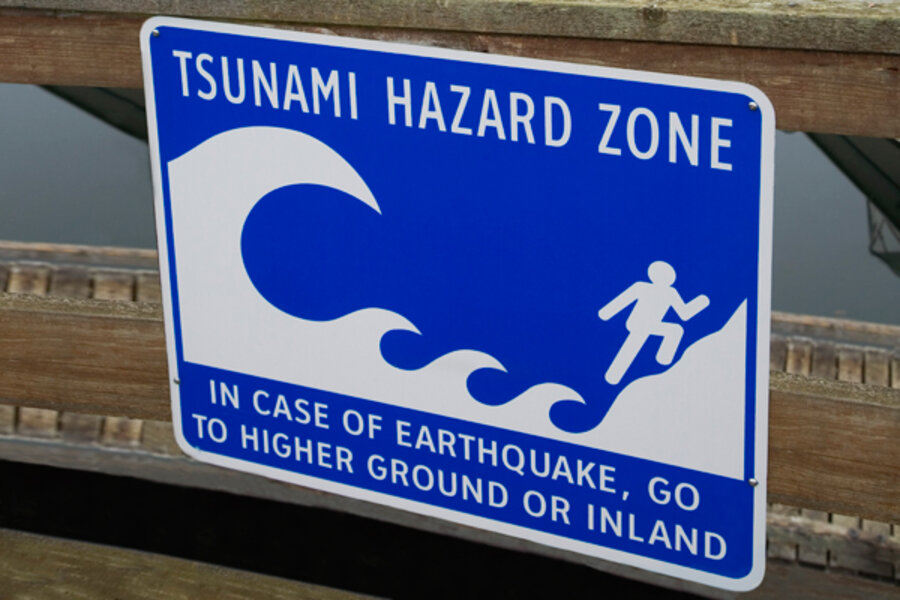Hawaii's tsunami warning: How the US is better prepared.
Loading...
From Australia to Alaska, coastal communities throughout the Pacific basin are bracing for tsunamis generated by a powerful earthquake that struck the central Chilean Coast just after 3:30 a.m. local time Saturday.
The undersea quake, which hit magnitude 8.8, unleashed some 500 times the amount of energy released by the quake that struck Port-au-Prince, Haiti, on Jan. 12. The epicenter is not far from the site of a temblor in 1960 that – at magnitude 9.5 – remains the most powerful quake on record.
The stricken area along the Chilean coast reported tidal waves some six feet above normal surf levels.
IN PICTURES: Images from the 8.8 magnitude earthquake in Chile
Warnings have been posted for the Hawaiian islands, New Zealand, and for portions of Australia’s east coast, among other locations. The US West Coast, British Columbia, and the Alaskan Coast are under tsunami advisories. So far, Japan has posted no advisories or warnings.
In Hawaii, forecasters aren’t certain how high the waves will be when they reach the islands, but suggest they could be the largest tidal waves to hit the state since the Alaskan earthquake of 1964, when 12.5-foot waves struck Hilo.
Awareness of tsunami hazards has heightened in recent years, following a magnitude 9.3 earthquake off the Indonesian island of Sumatra in December 2004. Tsunamis the quake generated struck the coastal city of Banda Aceh, killing nearly 178,000 people.
Improving tsunami forecasts
Before the quake, the US had deployed only six tsunami-detection buoys, largely as tools for exploring ways to improve tsunami forecasts, according to Helmit Poartmann, director of the National Oceanic and Atmospheric Administration’s National Data Buoy Center near Biloxi, Miss. Now, the center has 39 buoys spread through the Pacific, in the Atlantic and Indian Oceans, and in the Caribbean Sea.
In addition, NOAA received funding to keep its two tsunami-warning centers, one based in Honolulu, the other in Palmer, Alaska, operating full time, notes Jenifer Rhoades, the tsunami program manager for the National Weather Service.
The additional data these buoys provide, combined with advanced models of the sea floor along coasts and the behavior of tsunamis as they radiate from their source, allow forecasters to constantly refine their projections of likely wave height at landfall.
The buoys, which are set out on the sea floor and awakened by seismic waves from a quake, use sensitive pressure detectors to spot a passing tsunami. Saturday’s quake was so strong, it activated buoys in the Atlantic and Caribbean, although no tsunamis are expected there.
Overall, Washington invested some $42 million to beef up seismic and tsunami detection and warning efforts.
What's the difference?
Tsunamis differ from ordinary waves in significant ways.
The swells that roll along the open ocean to become a surfer’s playground originate at the surface as wind blows across it. Tsunamis, triggered by a sudden change in sea-floor height from an undersea quake, or from an undersea landslide involve the movement of an entire vertical extent of ocean.
As they reach shallow water offshore, they slow down and build in height. At sea, a tsunami’s height can be measured in inches and so are hard to detect at the surface. When they reach shore, however, they can mount to heights of several feet above normal surf levels.
Tsunami events typically involve several waves arriving over several hours. And the first wave isn’t necessarily the tallest, Ms. Rhoades explains.
Where a tsunami meets a bay or inlet, tsunami height is further magnified. In Alaska’s Cook Inlet, tsunami heights from the ‘64 quake topped 100 feet at some locations.
Yet it doesn’t take an overwhelming wall of water to inflict serious damage, Rhoades cautions. She points out that in flash floods, two inches of water can knock a person over.
“With a tsunami, even a foot of water moving at 35 miles an hour endangers life and property,” she warns.
IN PICTURES: Images from the 8.8 magnitude earthquake in Chile
------------





